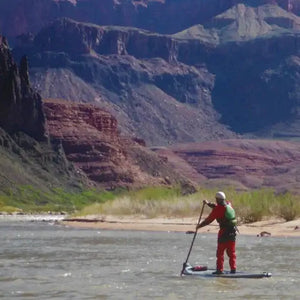Why the Petzl GriGri Keeps on Sending
November 13, 2022

After all these years, the Petzl GriGri is still the most widely trusted assisted braking belay device on the market. It sets the benchmark against which all other devices are compared. While there have been some worthy runner-ups, the GriGri’s tried-and-true design and durability have made it hard to beat. It’s so popular, in fact, that, in common climber parlance, the word grigri has come to mean any assisted-braking belay device. (Fun fact: the name came from a West African word for “good luck charm.”)
The first of its kind, the original GriGri hit local crags in 1991 and, with proper use and an attentive belayer, has made rock-climbing and rappelling safer ever since. In 2011, the GriGri2—a lighter, more ergonomic model—was released to replace the original. In 2017, Petzl added the GriGri+ to its offering, increasing durability, functionality, and safety. Both the GriGri2 and GriGri+ are available for purchase at Outdoorplay.
While maintaining the GriGri2’s hand-feel and performance, Petzl added one feature in particular to the GriGri+ that made this reviewer opt for the more expensive upgrade. I’ll explain why further down this post. First, I want to talk about the winning design that makes both models a sender’s choice.
How it works:
The GriGri is incredibly easy to use. With both models, the belay hand motion is the same as it is with a classic tube style device like the ATC: one hand feeds out slack (or takes it in when top-roping), the other hand grips the brake end. The difference between a tube-style and an assisted braking device is that, with the latter, the rope runs internally along a cam, which allows the rope to pass if moving slowly, but when the rope moves quickly, the cam will rotate, pinching the rope. Put more simply, when the device experiences a high enough shock load, like a lead fall, it locks-off. When fully engaged, the camming mechanism also helps hold a climber in place, allowing the climber to hang on the rope and work out a move without exhausting the belayer.
But, remember, the GriGri is an assisted braking device, not an automatic braking device.
Even though the GriGri never fails, GriGri related accidents happen too often due to misuse and human error. In no uncertain terms, Petzl lays it out on their website: "Always hold the brake side of the rope!" Unbeknownst to many climbers, there are actually a few situations when the cam might not engage on its own.
For instance:
- With super-skinny ropes below the recommended range.
- With an extremely light climber.
- On routes with bulges or significant rope drag that reduce the forces of a fall.
- Hanging on the rope mid-route.
Also, while the engraved diagrams on both the inside and outside of the device are very straight forward—climber on one end, hand on the other—you need to take extreme care when lacing the rope through the slot. Friction goes one way. If the rope isn’t oriented in the right direction, the device won’t brake. To double check your work, pull up hard on the climber’s end of the rope to make sure the cam locks off. Likewise, when you’re the climber, check to make sure the belayer threaded the GriGri correctly. It takes 2 seconds and could save your life.
Why I chose to switch to the GriGri+:
Firstly, the GriGri+ has everything I love about the GriGri2. It’s lightweight (though modestly heavier than its predecessor), super bomber, easy to use, and has a strong, reliable catch. Which begs the question, what did I gain in making the switch?
The Anti-Panic Handle
I am a climber who wants every added layer of security she can get, especially if it mitigates the risk of human error—and the anti-panic function was designed to do just that. With the GriGri+, if a belayer pulls too hard on the lowering handle, the cam will lock, preventing an uncontrolled descent and possible ground fall. For me, this is a no-brain reason to upgrade.
While the anti-panic function is especially useful for beginners who are more likely to pull too hard on the lever and then panic and not let go, experienced climbers are not immune to making mistakes. Too often when lowering climbers, belayers forget to let go of the handle while working out kinks in the rope, which results in the climber shooting towards the ground when the kink is released. Also, when a belayer weighs significantly less than the climber, it’s harder for the belayer to control the velocity of descent. The new and improved camming mechanism in the GriGri+ means you get more sensitivity when lowering.
The new GriGri+ also offers:
- A stainless steel friction plate and wear plate, making it more durable in sandy conditions
- A wider acceptable rope range. It’s designed for all single ropes between 8.5 mm and 11 mm, and optimal for 8.9 to 10.5 mm diameters. Though I own ropes in the mid-9 mm range, I like knowing I can jump on a route with a friend’s skinny rope and still enjoy the peace of mind I get from my GriGri.
- Lead and Top Rope modes, resulting in a better belay experience. Lead mode provides a more dynamic belay and allows you to pay out rope a bit easier than with the GriGri2. And Top Rope mode provides a tighter cam so you can 1) barely feed out slack, and 2) capture progress when taking in slack much more efficiently.
- In short, the GriGri+ offers added safety, durability, and comfort that I think warrants the higher ticket price.
Lastly, don’t forget your belay gloves and belay glasses. Not only will you have more control and a be more attentive belayer, your hands and neck will hurt a lot less.
The GriGri is available for purchase at Outdoorplay, with free shipping to the contiguous United States.
